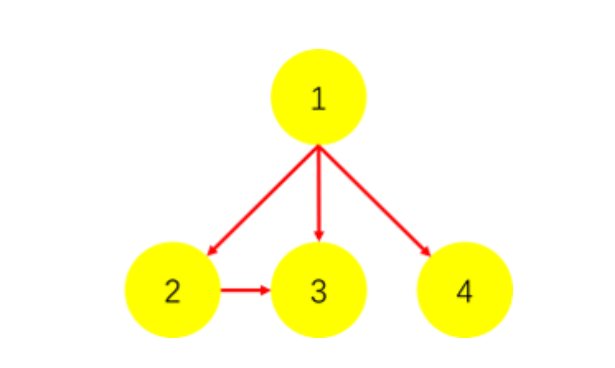堆优化的dijkstra板子*
对于单源最短路的问题,目前已知最快的解决算法就是堆优化处理过的dijkstra(条件当然是不存在负边的情况下,若存在负边的情况则要用spfa辽,但是蒻苟不会嘻嘻🤭)
dijkstra的本质是贪心,对于求目标两个位置间的最短权边和,查找从起点位置到每个点的最短距离,同时更新与该当前点相关的点的距离。
这种存图方式只需要开一个数组存储每个点引出的第一条边,然后存储每个点作为起点的每条边,这样就可以做到不重不漏。
在链式前向星存图中,我们需要定义一个结构体:
1
2
3
4
5
| struct EDGE
{
int next;
int to;
}edge[1000000];
|
和一个数组
和一个变量:
你会发现竟然没存起点!!其实起点是用headhead存的
举例:

如图:这样的一个有向图,输入是:
逐步分析:
1.输入1 2,代表1连向2。
1
2
3
| cnt++;//作为结构体下标,没有意义
head[1]=cnt;//结点1的第一个儿子存在了edge[cnt]里面
edge[cnt].to=2;结点1的儿子是2
|
此时: cnt=1

2.输入1 3,代表1连向3。
1
2
3
4
5
6
7
8
9
10
| cnt++;
head[1]=cnt;
edge[cnt].to=3;结点1的儿子是3
//这时,3成为了结点1的儿子,不过2被挤了下去...
//所以要引入结构体中next元素,记录:3还有个兄弟(next)是2
//所以代码要换成:
cnt++;
edge[cnt].to=3;//结点1连向3
edge[cnt].next=head[1];//3的兄弟是2
head[1]=cnt;//更新head
|
此时: cnt=2

3.输入1 4,代表1连向4。
此时cnt=3

4.输入2 3,代表2连向3。
此时: cnt=4

可以理解的是,next存的是当前结点连接的最近的兄弟结点的下标,如1->2,1->3,1->4,则4的next是3,3的next是2。
而head 存的是当前结点指向的最远的结点的下标,1->2,1->3,则head [1] =3,
对于带权值的问题,在结构体中加入一个元素记录权值即可
代码:(带权值)
1
2
3
4
5
6
7
8
9
10
11
12
13
14
15
16
17
18
19
20
21
22
23
24
25
26
27
28
| #include<iostream>
using namespace std;
struct edge
{
int next;
int to;
int wei;
}edge[MAXM];
int head[MAXN];
int cnt=0;
void addedge(int u,int v,int w)
{
edge[++cnt].next=head[u];
edge[cnt].to=v;
edge[cnt].w=w;
head[u]=cnt;
}
int main()
{
int n;
for(int i=1;i<=n;i++)
{
int a,b,wei;
addedge(a,b,wei);
}
}
|
边的遍历
在遍历以x为起点的所有边时,只需要这样就行
1
2
| for(int i=head[x];i!=0;i=edge[i].next)
|
这个循环的结束条件是i等于0,因为最后一条边,也就是存边时第一条边,在把head值存进next时,head还没有更新过,也就是0。所以当next返回0时,就说明这些边遍历完毕了。
代码
堆优化
在寻找最短值的时候,用优先队列priority_queue<pair<int,int>>来存储,其中的pair中记录的分别是每条边的权值和终点结点。
优化完成后的总复杂度为O(mlogn)
1
2
3
4
5
6
7
8
9
10
11
12
13
14
15
16
17
18
19
20
21
22
23
24
25
26
27
28
29
30
31
32
33
34
35
36
37
38
39
40
41
42
43
44
45
46
47
48
49
50
51
| #include <bits/stdc++.h>
#define rep(i,n,m) for(int i=n;i<=m;++i)
#define per(i,n,m) for(int i=n;i>=m;--i)
#define INF 0x3f3f3f3f
using namespace std;
typedef long long ll;
const int N=250010;
int head[N],ne[N],to[N],w[N],dist[N];
bool st[N];
int n,m,s,cnt=0;
void addw(int a,int b,int c){
w[++cnt]=c;
to[cnt]=b;
ne[cnt]=head[a];
head[a]=cnt;
}
void Dijkstra()
{
priority_queue<pair<int,int>,vector<pair<int,int>>,greater<pair<int,int>>> heap;
heap.push({0,s});dist[s]=0;
while(!heap.empty()){
pair<int,int> temp=heap.top();
heap.pop();
int x=temp.first,y=temp.second;
if(st[y])continue;
st[y]=true;
for(int i=head[y];i!=0;i=ne[i]){
int t=to[i];
if(dist[t]>x+w[i]){
dist[t]=x+w[i];
heap.push({dist[t],t});
}
}
}
}
int main()
{
cin>>n>>m;
memset(dist,INF,sizeof(dist));
for(int i=1;i<=m;++i){
int a,b,c;cin>>a>>b>>c;
addw(a,b,c);
}
Dijkstra();
rep(i,1,n)cout<<dist[i]<<' ';
return 0;
}
|
带负权边问题的spfa算法之后再考虑学不学🙄🙄🙄🙄







